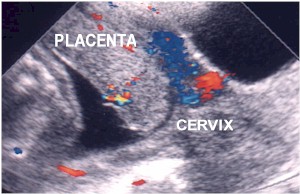Placenta Previa
Jump to navigation
Jump to search
Previa is the term used to describe the covering of the cervix by the placenta. Normally the placenta develops anteriorly, posteriorly or laterally on the sides of the uterus. However in this condition the placenta is low in the uterus, near or covering over the cervix. A complete placenta previa occurs when placenta completely covers the cervix. A partial previa occurs when it extends to the opening of the cervix. The placenta is termed low-lying if the tip of the placenta is within 2 centimeters of the opening to the cervix.
The risk factors for this condition are
Placenta previa occurs when the embryo implants near the cervix. It is common, especially up to 22-24 weeks and rarely causes significant problems during this time. As many as 20% of early pregnancies are partial placenta previas, but by the third trimester 90% have resolved. Usually as the uterus enlarges the placenta pulls away from the cervix. If placenta previa or low-lying placenta persists there may be vaginal bleeding. This is because vulnerable placental blood vessels are exposed near the cervix. Bleeding may be once off or regular but often there is no bleeding. If there are many contractions of the uterus during the pregnancy there is a greater chance that bleeding episodes will occur.
A low-lying placenta almost always resolves by delivery, especially when it is diagnosed early in the pregnancy. When the placental tip is more than 2 cm from the internal os, most women are able to deliver vaginally without significant bleeding.
When a previa does not resolve, then delivery becomes more complicated. If a placenta previa is still present by the time a woman is term, then a Cesarean section is the only safe option for delivery of the fetus. It is unsafe to attept labor with a placenta sitting less than 2cm or over the cervix.
Complications of placenta previa include premature delivery, life-threatening maternal hemorrhage, increased risk of placenta accreta, increased risk of post-partum hemorrhage, and intrauterine growth retardation.
Placenta previa is also a risk factor for placenta accreta, when the placenta becomes abnormally invasive into the wall of the uterus.
Go Back to Obstetrics Homepage
Previa is the term used to describe the covering of the cervix by the placenta. Normally the placenta develops anteriorly, posteriorly or laterally on the sides of the uterus. However in this condition the placenta is low in the uterus, near or covering over the cervix. A complete placenta previa occurs when placenta completely covers the cervix. A partial previa occurs when it extends to the opening of the cervix. The placenta is termed low-lying if the tip of the placenta is within 2 centimeters of the opening to the cervix.
The risk factors for this condition are
- Multiple prior pregnancies
- Ceserean deliveries
- Advanced maternal age
- Smoking
Placenta previa occurs when the embryo implants near the cervix. It is common, especially up to 22-24 weeks and rarely causes significant problems during this time. As many as 20% of early pregnancies are partial placenta previas, but by the third trimester 90% have resolved. Usually as the uterus enlarges the placenta pulls away from the cervix. If placenta previa or low-lying placenta persists there may be vaginal bleeding. This is because vulnerable placental blood vessels are exposed near the cervix. Bleeding may be once off or regular but often there is no bleeding. If there are many contractions of the uterus during the pregnancy there is a greater chance that bleeding episodes will occur.
A low-lying placenta almost always resolves by delivery, especially when it is diagnosed early in the pregnancy. When the placental tip is more than 2 cm from the internal os, most women are able to deliver vaginally without significant bleeding.
When a previa does not resolve, then delivery becomes more complicated. If a placenta previa is still present by the time a woman is term, then a Cesarean section is the only safe option for delivery of the fetus. It is unsafe to attept labor with a placenta sitting less than 2cm or over the cervix.
Complications of placenta previa include premature delivery, life-threatening maternal hemorrhage, increased risk of placenta accreta, increased risk of post-partum hemorrhage, and intrauterine growth retardation.
Placenta previa is also a risk factor for placenta accreta, when the placenta becomes abnormally invasive into the wall of the uterus.
Go Back to Obstetrics Homepage
